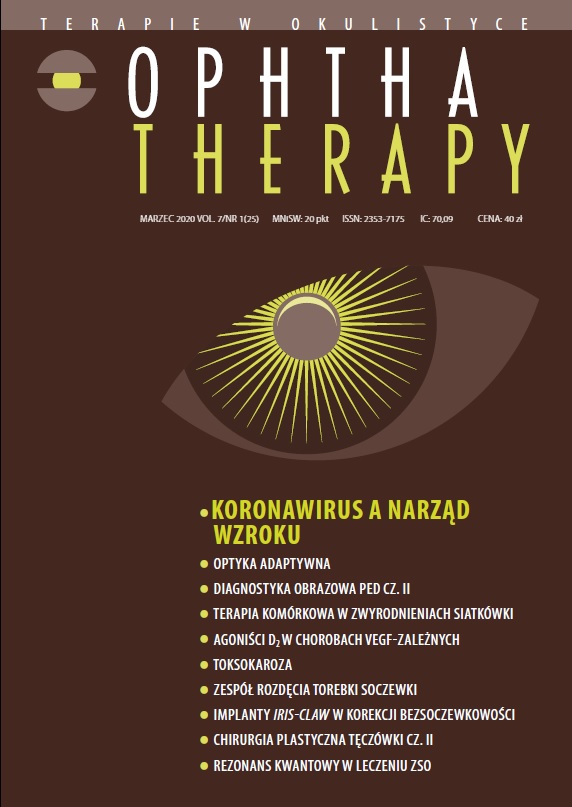Zoonoses in ophthalmology. Part 2. Ocular larva migrans syndrome Review article
Main Article Content
Abstract
Ocular toxocariasis, or ocular larva migrans syndrome, is a parasitic disease of the eye caused by non-human species of roundworms, usually canine (Toxocara canis), which accidentally migrated into the eyeball. Although this disease is rare, in Poland it is the second infectious cause of posterior uveitis (11.8%). Additional and commercially available research in Poland that can be useful in this disease is of limited value, so the diagnosis should be clinical. This article gathers data from the literature on epidemiology, clinical course, diagnosis and actual principles of ocular toxocariasis treatment described from the point of view of an experienced infectious and parasitic diseases specialist.
Downloads
Article Details

This work is licensed under a Creative Commons Attribution-NonCommercial-NoDerivatives 4.0 International License.
Copyright: © Medical Education sp. z o.o. License allowing third parties to copy and redistribute the material in any medium or format and to remix, transform, and build upon the material, provided the original work is properly cited and states its license.
Address reprint requests to: Medical Education, Marcin Kuźma (marcin.kuzma@mededu.pl)
References
2. Deplazes P, van Knapen F, Schweiger A et al. Role of pet dogs and cats in the transmission of helminthic zoonoses in Europe, with a focus on echinococcosis and toxocarosis. Veterinary Parasitology. 2011; 182(1): 41-53. https://doi.org/10.1016/j.vetpar.2011.07.014.
3. Mizgajska-Wiktor H, Jarosz W. A comparison of soil contamination with Toxocara canis and Toxocara cati eggs in rural and urban areas of Wielkopolska district in 2000-2005. Wiad Parazytol. 2007; 53: 219-25.
4. Luty T. Prevalence of species of Toxocara in dogs, cats and red foxes from the Poznan region, Poland. J Helmintol. 2001; 75: 153-6.
5. Maśnik E. [Relationships between the prevalence of Toxocara eggs in dogs’ faeces and soil]. Wiad Parazytol. 2000; 46: 239-44.
6. Brydak-Godowska J, Moskal K, Borkowski PK et al. A Retrospective Observational Study of Uveitis in a Single Center in Poland with a Review of Findings in Europe. Med Sci Monit. 2018; 24: 8734-49. https://doi.org/10.12659/MSM.910749.
7. Hermanowska-Szpakowicz T, Kondrusik M, Świerzbińska M et al. [Incidence of antibody detection agaimnst Toxocara canis and clinical symptoms in inhabitans of North-Eastern Poland. Pol Merkur Lek. 2001; 10: 168-70.
8. Łapiński TW, Miegoć H, Prokopowicz D et al. [Exposure to toxocariasis and tularemia among workers at Białowieza National Park]. Przegl Epidemiol. 2000; 54: 367-74.
9.Amaral HL, Rassier GL, Pepe MS et al. Presence of Toxocara canis eggs on the hair of dogs: a risk factor for Visceral Larva Migrans. Vet Parasitol. 2010; 174(1-2): 115-8. https://doi.org/10.1016/j.vetpar.2010.07.016.
10. Keegan JD, Holland CV. A comparision of Toxocara canis embrionation under controlled conditions in soil and hair. J Helmintol. 2012; 16: 1-7.
11. Morimatsu Y, Akao N, Akiyoshi H et al. A familial case of visceral larva migrans after ingestion of raw chicken livers: appearance of specific antibody in bronchoalveolar lavage fluid of the patients. Am J Trop Med Hyg. 2006; 75(2): 303-6.
12. Hugot JP, Reinhard KJ, Gardner SL et al. Human enterobiasis in evolution: Origin, specificity and transmission. Parasite. 1999; 6(3): 201-8.
13. U.S. Department of Health & Human Services, Center for Disease Control and Prevention. Toxocariasis. https://www.cdc.gov/parasites/toxocariasis/epi.html. (Access: 24.03.2020).
14. Roddie G, Holland C, Stafford P et al. Contamination of fox hair with eggs of Toxocara canis. J Helminthol. 2008; 82: 293-6. https://doi.org/10.1017/S0022149X08996954.
15. U.S. Department of Health & Human Services, Center for Disease Control and Prevention. Toxocariasis. https://doi.org/https://www.cdc.gov/parasites/toxocariasis/health_professionals/index.html. (Access: 24.03.2020).
16.Dangoudoubiyam S, Kazacos KR. Differentiation of larva migrans caused by Baylisascaris procyonis and Toxocara species by Western blotting. Clin Vaccine Immunol. 2009; 16(11): 1563-8. https://doi.org/10.1128/CVI.00251-09.
17. Paul M, Stefaniak J, Twardosz-Pawlik H et al. The co-occurrence of Toxocara ocular and visceral larva migrans syndrome: a case series. Cases J. 2009; 2: 6881. https://doi.org/10.1186/1757-1626-2-6881.
18. Alabiad CR, Albini TA, Santos CL et al. Ocular toxocariasis in a seronegative adult. Ophtalmic Surg Lasers Imaging. 2010; 2: 1-3.
19. Bertelmann E, Velhagen KH, Pleyer U et al. Okulare Toxocariasis. Der Ophthalmologe. 2003; 100(11): 950-4. https://doi.org/10.1007/s00347-003-0815-1.
20. de Visser L, Rothova A, de Boer JH et al. Diagnosis of ocular toxocariasis by establishing intraocular antibody production. Am J Ophthalmol. 2008; 145(2): 369-74.
21. Higashide T, Akao N, Shirao E et al. Optical coherence tomographic and angiographic findings of a case with subretinal toxocara granuloma. Am J Ophthalmol. 2003; 136(1): 188-90.
22. Ahn SJ, Woo SJ, Hyon JY et al. Cataract formation associated with ocular toxocariasis. J Cataract Refract Surg. 2013; 39: 830-5.
23. Mansour AM, Abiad B, Boulos FI et al. Adult Ocular Toxocariasis Mimicking Ciliary Body Malignancy. Case Rep Med. 2014; 2014: 1-5.
24. Suzuki T, Joko T, Akao N et al. Following the migration of a Toxocara larva in the retina by optical coherence tomography and fluorescein angiography. Jpn J Ophthalmol. 2005; 49(2): 159-61. https://doi.org/10.1007/s10384-004-0157-9.
25. Stürchler D, Schubarth P, Gualzata M et al. Thiabendazole vs. albendazole in treatment of toxocariasis: a clinical trial. Ann Trop Med Parasit. 1989; 83(5): 473-8. https://doi.org/10.1080/00034983.1989.11812374.

